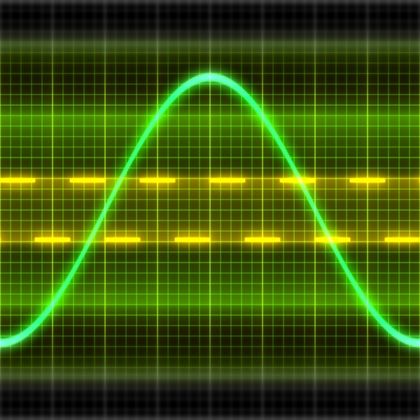Oscillation - How it works

Stable and Unstable Equilibrium
When a state of equilibrium exists, the vector sum of the forces on an object is equal to zero. There are three varieties of equilibrium: stable, unstable, and neutral. Neutral equilibrium, discussed in the essay on Statics and Equilibrium elsewhere in this book, does not play a significant role in oscillation; on the other hand, stable and unstable equilibrium do.
In the example of a playground swing, when the swing is simply hanging downward—either empty or occupied—it is in a position of stable equilibrium. The vector sums are balanced, because the swing hangs downward with a force (its weight) equal to the force of the bars on the swing set that hold it up. If it were disturbed from this position, as, for instance, by someone pushing the swing, it would tend to return to its original position.
If, on the other hand, the swing were raised to a certain height—if, say, a child were swinging and an adult caught the child at the point of maximum displacement—this would be an example of unstable equilibrium. The swing is in equilibrium because the forces on it are balanced: it is being held upward with a force equal to its weight. Yet, this equilibrium is unstable, because a disturbance (for instance, if the adult lets go of the swing) will cause it to move. Since the swing tends to oscillate, it will move back and forth across the position of stable equilibrium before finally coming to a rest in the stable position.
Properties of Oscillation
There are two basic models of oscillation to consider, and these can be related to the motion of two well-known everyday objects: a spring and a swing. As noted below, objects not commonly considered "springs," such as rubber bands, display spring-like behavior; likewise one could substitute "pendulum" for swing. In any case, it is easy enough to envision the motion of these two varieties of oscillation: a spring generally oscillates along a straight line, whereas a swing describes an arc.
Either case involves properties common to all objects experiencing oscillation. There is always a position of stable equilibrium, and there is always a cycle of oscillation. In a single cycle, the oscillating particle moves from a certain point in a certain direction, then reverses direction and returns to the original point. The amount of time it takes to complete one cycle is called a period, and the number of cycles that take place during one second is the frequency of the oscillation. Frequency is measured in Hertz (Hz), with 1 Hz—the term is both singular and plural—equal to one cycle per second.

It is easiest to think of a cycle as the movement from a position of stable equilibrium to one of maximum displacement, or the furthest possible point from stable equilibrium. Because stable equilibrium is directly in the middle of a cycle, there are two points of maximum displacement. For a swing or pendulum, maximum displacement occurs when the object is at its highest point on either side of the stable equilibrium position. For example, maximum displacement in a spring occurs when the spring reaches the furthest point of being either stretched or compressed.
The amplitude of a cycle is the maximum displacement of particles during a single period of oscillation, and the greater the amplitude, the greater the energy of the oscillation. When an object reaches maximum displacement, it reverses direction, and, therefore, it comes to a stop for an instant of time. Thus, the speed of movement is slowest at that position, and fastest as it passes back through the position of stable equilibrium. An increase in amplitude brings with it an increase in speed, but this does not lead to a change in the period: the greater the amplitude, the further the oscillating object has to move, and, therefore, it takes just as long to complete a cycle.
Restoring Force
Imagine a spring hanging vertically from a ceiling, one end attached to the ceiling for support and the other free to hang. It would thus be in a position of stable equilibrium: the spring hangs downward with a force equal to its weight, and the ceiling pulls it upward with an equal and opposite force. Suppose, now, that the spring is pulled downward.
A spring is highly elastic, meaning that it can experience a temporary stress and still rebound to its original position; by contrast, some objects (for instance, a piece of clay) respond to deformation with plastic behavior, permanently assuming the shape into which they were deformed. The force that directs the spring back to a position of stable equilibrium—the force, in other words, which must be overcome when the spring is pulled downward—is called a restoring force.
The more the spring is stretched, the greater the amount of restoring force that must be overcome. The same is true if the spring is compressed: once again, the spring is removed from a position of equilibrium, and, once again, the restoring force tends to pull it outward to its "natural" position. Here, the example is a spring, but restoring force can be understood just as easily in terms of a swing: once again, it is the force that tends to return the swing to a position of stable equilibrium. There is, however, one significant difference: the restoring force on a swing is gravity, whereas, in the spring, it is related to the properties of the spring itself.
Elastic Potential Energy
For any solid that has not exceeded the elastic limit—the maximum stress it can endure without experiencing permanent deformation—there is a proportional relationship between force and the distance it can be stretched. This is expressed in the formula F = ks, where s is the distance and k is a constant related to the size and composition of the material in question.
The amount of force required to stretch the spring is the same as the force that acts to bring it back to equilibrium—that is, the restoring force. Using the value of force, thus derived, it is possible, by a series of steps, to establish a formula for elastic potential energy. The latter, sometimes called strain potential energy, is the potential energy that a spring or a spring-like object possesses by virtue of its deformation from the state of equilibrium. It is equal to ½ ks 2 .
POTENTIAL AND KINETIC ENERGY.
Potential energy, as its name suggests, involves the potential of something to move across a given interval of space—for example, when a sled is perched at the top of a hill. As it begins moving through that interval, the object will gain kinetic energy. Hence, the elastic potential energy of the spring, when the spring is held at a position of the greatest possible displacement from equilibrium, is at a maximum. Once it is released, and the restoring force begins to move it toward the equilibrium position, potential energy drops and kinetic energy increases. But the spring will not just return to equilibrium and stop: its kinetic energy will cause it to keep going.
In the case of the "swing" model of oscillation, elastic potential energy is not a factor. (Unless, of course, the swing itself were suspended on some sort of spring, in which case the object will oscillate in two directions at once.) Nonetheless, all systems of motion involve potential and kinetic energy. When the swing is at a position of maximum displacement, its

Thanks.